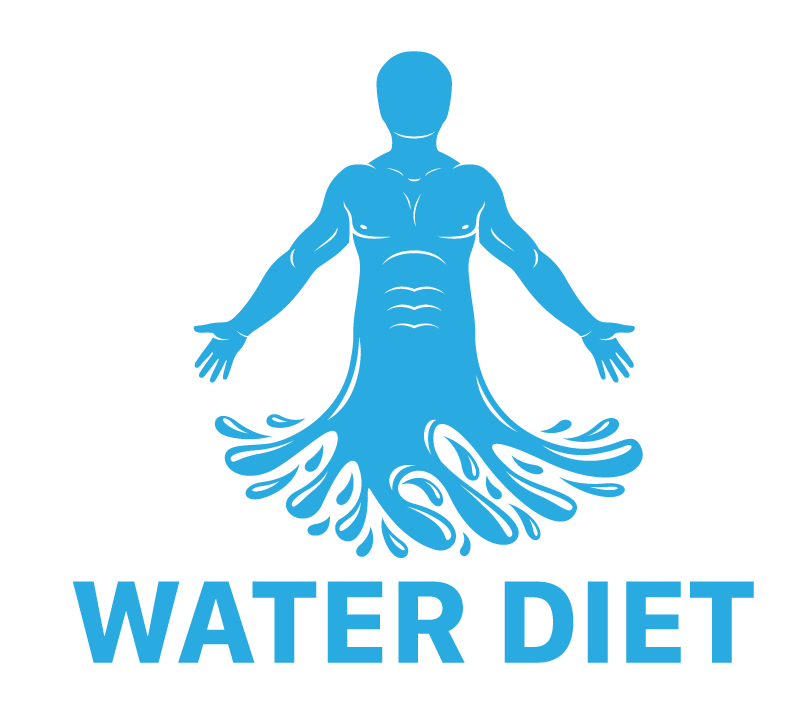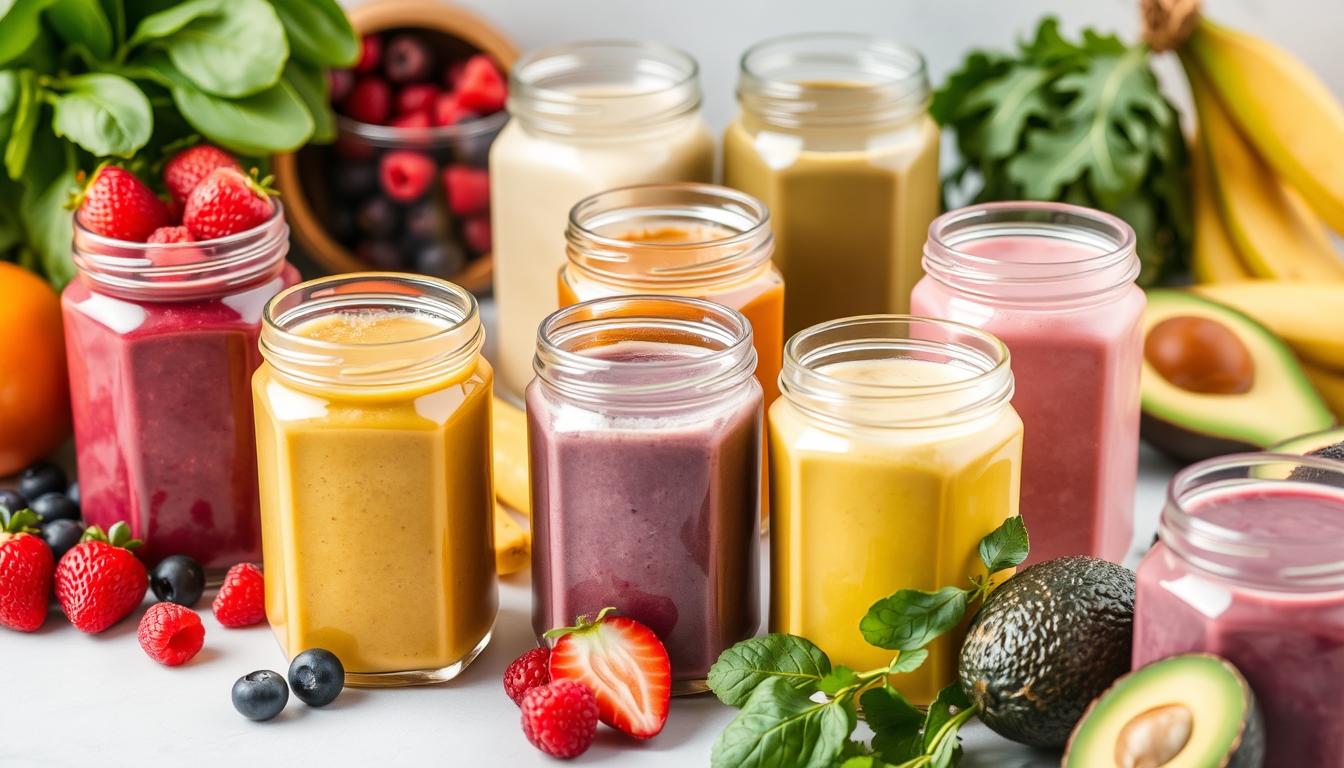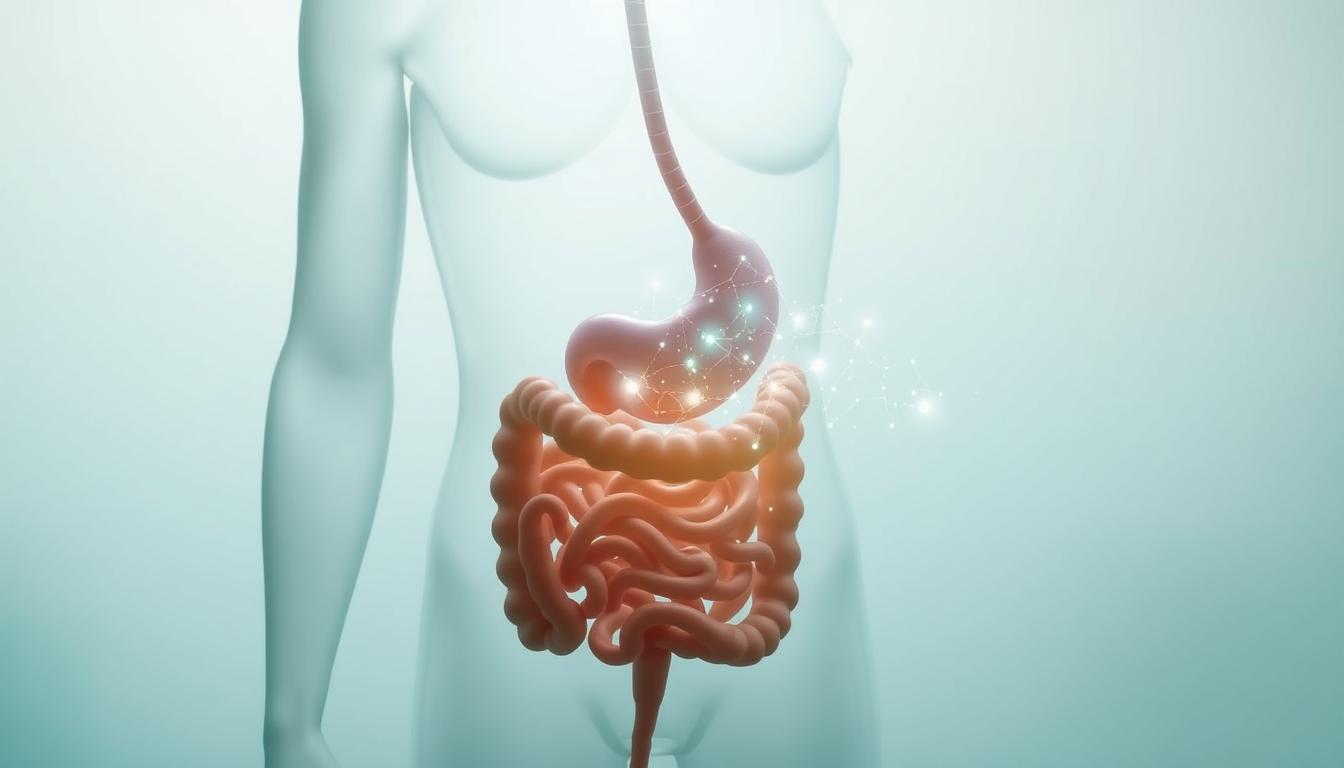Welcome to the ultimate Beginner’s Guide to Liquid Dieting! Are you looking to lose weight or add Healthy drinks to your life? You’re in the right spot. Liquid dieting is more than just clear broths. It’s a world of vibrant vegetable juices, nutritious smoothies, and shakes that build muscle.
I’ll share how your body can get the nutrients it needs on a liquid diet. The key is to stay hydrated, get enough protein, and choose nutrient-rich liquids. It’s also smart to talk to a dietitian to make sure your liquid diet is good for you in the long run.
Key Takeaways
- Liquid dieting includes more than just clear broths; it’s rich in shakes, smoothies, and other nutrient-dense beverages.
- Hydration is paramount; never substitute all solid food with liquids without ensuring adequate water intake.
- Protein is crucial to preserve muscle mass during liquid dieting.
- A variety of Healthy drinks can be included in a liquid diet, with each offering unique benefits.
- Consulting with a dietitian can optimize a liquid diet for Weight loss and overall health.
- Frozen fruits, natural sweeteners, and superfoods can enhance both the texture and nutritional value of smoothies.
- Plant-based milks cater to dairy-free diet preferences while offering creamy, rich bases for shakes and smoothies.
Introduction to Liquid Dieting
Liquid dieting is not just a modern trend. It has a long history of improving health and wellness. It’s known for helping with weight loss by using juices, smoothies, and other nutrient-rich beverages.
When you start a liquid diet, it’s important to watch your calorie intake. But it’s also key to stay hydrated and get all the nutrients your body needs. This is because you’re replacing solid foods with liquid alternatives.
People often choose liquid diets for digestive issues or to make it easier to absorb nutrients when they’re recovering. If you’re thinking about trying it, talk to a doctor first. This is especially true if you have any health problems. It’s not just about losing weight; it’s about keeping your health and hydration in check.
Here’s why hydration is so important:
- Drinking enough water is vital to avoid dehydration. This is because solid foods, which have water in them, are reduced.
- Water helps your body work well when you’re making big changes to your diet.
But, there are challenges:
- Not eating solid foods can lead to a lack of important vitamins and minerals if not managed right.
- Liquid diets can cause tiredness and sadness because of not eating enough calories. This shows the need for careful planning.
Starting a liquid diet means thinking carefully about what you eat, how many calories you have, and how much water you drink. It’s important to make sure you’re getting enough nutrients and staying hydrated. Remember, this diet might not be right for everyone. It’s important to tailor it to your health and lifestyle for it to work well.
Understanding the Basics of Liquid Diets
Starting a liquid diet means you’ll only eat liquids like water, smoothies, and shakes. This can be good for your health. It’s important to know what a liquid diet is and the different kinds available.
What Is a Liquid Diet?
A liquid diet only includes liquids or foods that turn to liquid at room temperature. It helps cut calories without losing important nutrients. People use it for health reasons, like before surgery or to help with digestion.
The Different Types of Liquid Diets
There are two main types of liquid diets. Knowing them can help you pick the right one for your health goals:
- Full Liquid Diet: This includes all liquids and foods that turn to liquid at room temperature. It’s used to move from a clear liquid diet to a normal diet.
- Clear Liquid Diet: This diet includes only clear, easy-to-digest liquids like water, clear broths, and pulp-free juices. It’s good for when you need to eat lightly.
Starting a full liquid diet can quickly change your weight and health. Here’s a quick look at what you might get nutritionally and calorically:
| Nutritional Component | Daily Requirement | Provided by Full Liquid Diet |
|---|---|---|
| Calories | 1,600 – 3,000 | 1,500 |
| Protein | 45 grams (minimum) | 45 grams |
| Duration of Diet | Varies | Typically less than 2 weeks |
| Potential Weight Loss | N/A | Sudden and significant |
Adding smoothies and shakes to your diet can make it more interesting. It helps you get enough protein, fats, and carbs. This keeps your muscles strong and your energy steady all day.
Unlocking the Nutritional Potential in Liquids
Exploring liquid dieting opens up a world of choices. These choices are both tasty and nutritious. The secret to a successful liquid diet is finding healthy drinks that are full of nutrients.
Protein is key in liquid dieting, especially from top-quality sources. Greek yogurt, for example, is packed with protein. This helps you feel full longer. It’s a great base for protein shakes, which are essential in a liquid diet.
Choosing fresh and frozen fruits and veggies over canned ones keeps nutrients high. It also avoids added sugars and preservatives. Using natural sweeteners like stevia and spices like cinnamon adds flavor without extra calories. This makes your diet both tasty and effective.
Here’s a mix of ingredients I’ve found helpful for keeping muscle mass and energy up on a liquid diet:
- Protein Sources: Clean protein powders, greek yogurt, or silken tofu boost protein without fillers.
- Smart Sweetening: Natural sweeteners like stevia or monk fruit extract keep blood sugar stable.
- Healthy Fats: Coconut oil or avocado add energy with their medium-chain fats.
- Flavor with Benefits: Cinnamon and cocoa powder add flavor and help with blood sugar and antioxidants.
| Ingredient | Benefits | Recommended Usage |
|---|---|---|
| Greek Yogurt | High protein, supports satiety | 1 cup per shake |
| Stevia | Zero-calorie sweetness | 1/4 teaspoon per shake |
| Coconut Oil | Medium-chain fats, energy boosting | 1 tablespoon per shake |
| Cinnamon | Regulates blood sugar | 1/2 teaspoon per shake |
Choosing the right ingredients makes a liquid diet effective for weight loss and health. A varied diet is key. These shakes should be part of a balanced intake of healthy drinks.
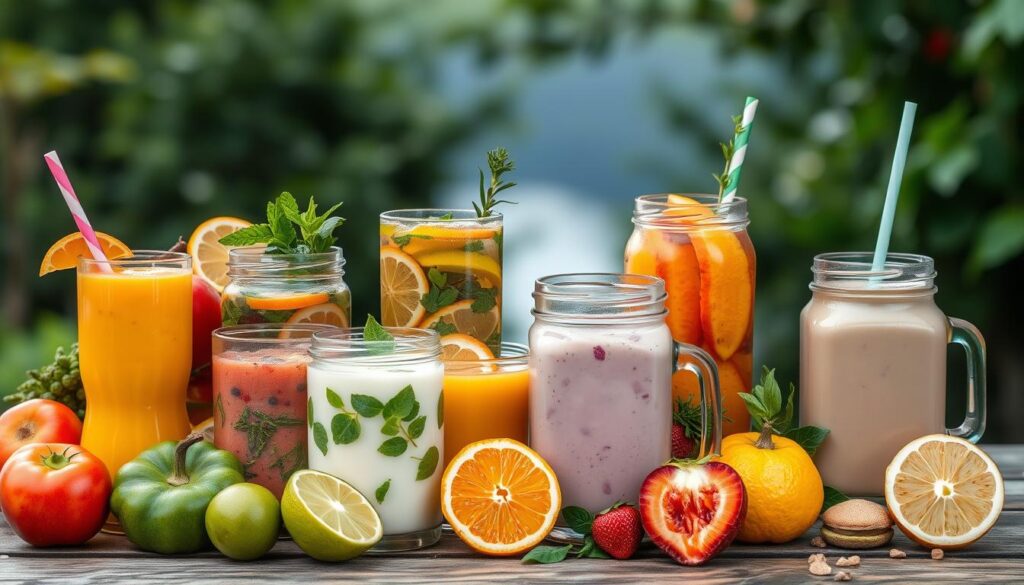
Adding these healthy drinks to your daily routine can greatly improve your health. It helps with weight management and ensures you get all the nutrients your body needs. Enjoy the mix of taste and health in your liquid diet for the best results.
Water, Smoothies, and Shakes: A Beginner’s Guide to Liquid Dieting
Starting a liquid diet means focusing on water, smoothies, and shakes. These are not just drinks; they help you get the nutrients you need. I’ll show you how to use them to keep your diet balanced and healthy.
As a beginner, it’s vital to understand that while smoothies and shakes can pack a meal’s worth of nutrients, water remains irreplaceable for hydration and health.
- Water: It’s the cornerstone of liquid dieting and vital for keeping the body hydrated and assisting in detoxification and metabolic processes.
- Smoothies: These can be a delicious way to consume a variety of fruits and vegetables. I frequently use Greek yogurt or banana to add creaminess, and a mix of berries for a vibrant flavor and antioxidant boost.
- Shakes: Typically more protein-centric, I find shakes ideal post-workout. A scoop of protein powder, some almond milk, and a dab of nut butter can make for a fulfilling mini-meal.
All about choices: Selecting the Right Ingredients
| Recipe | Calories | Protein (g) | Carbs (g) | Sugars (g) | Fat (g) |
|---|---|---|---|---|---|
| Tropical Chia Smoothie | 255 | 4 | 43 | 27.5 | 8 |
| Green Pineapple Coconut Smoothie | 192 | 4 | 30 | 11.5 | 7 |
| Spiced Blueberry Smoothie Bowl | 325 | 22 | 52 | 29 | 5.5 |
| Peach Blueberry Smoothie | 170 | 8.5 | 26 | 17 | 4 |
For anyone new to liquid dieting, start with smoothies and shakes that are balanced. For breakfast, try the Green Pineapple Coconut Smoothie. It’s low in calories but packed with nutrients. The key is to mix and match ingredients to avoid missing out on important nutrients.
Switching to a liquid diet, especially with smoothies and shakes, offers flexible and tasty meal options. It’s a great way for beginners to keep their diet interesting and easy to follow. Start with simple recipes and then explore to find your favorite combinations that boost your energy and meet your nutritional needs.
Blending Up Health: Incorporating Smoothies and Shakes Into Your Diet
Exploring liquid dieting, many are drawn to protein shakes and green smoothies. These drinks are not just tasty but also key to a balanced diet. They help with weight management and provide essential nutrients.
Benefits of Protein-Packed Shakes
Protein shakes are vital for those on a liquid diet. They keep muscles strong and control hunger. These shakes can replace meals or snacks, helping you eat fewer calories without losing out on nutrients.
Choosing high-quality protein powders, like whey or plant-based options, is important. It ensures your body gets the nutrients it needs, especially when you’re trying to lose or manage weight.
Green Smoothies: A Nutrient-Rich Beverage
Green smoothies add color and nutrients to your day. They mix leafy greens with fruits, offering vitamins, minerals, and fiber. These smoothies boost digestion and skin health.
They also make it easy to eat more veggies and fruits. Adding chia seeds or flaxseeds gives them extra fats and proteins. This makes them a complete, healthy drink.
Adding protein shakes and green smoothies to your diet meets many nutritional needs. It keeps meals interesting and fresh. With so many recipes out there, you can always try something new. This makes sticking to a liquid diet easier and more enjoyable.
The secret to a successful liquid diet is variety and balance. Each drink should bring you closer to your health goals.
Liquid Dieting and the Importance of Hydration
Starting a liquid diet changes how your body gets nutrients and stays hydrated. It’s key to keep your body hydrated because it affects your health, digestion, and diet success.
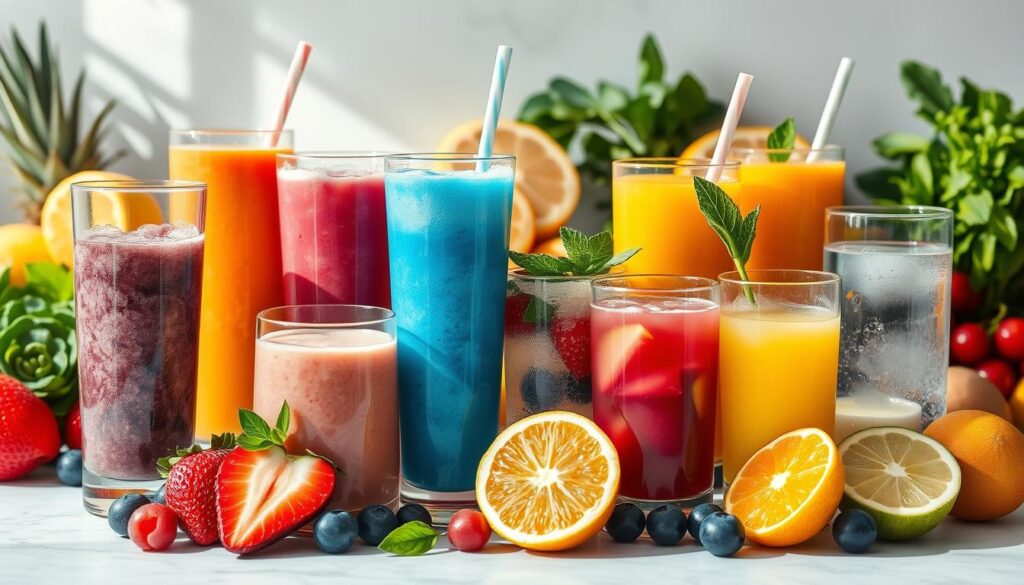
With solid meals replaced by liquids, hydration is more important. Usually, we get a lot of water intake from solid foods. Without them, we need to drink more water to stay hydrated.
Ensuring Adequate Water Intake
To avoid dehydration, make sure you drink enough water on a liquid diet. Experts say to drink at least 64 ounces of water a day. This helps your body work well and supports effective weight loss.
Hydration’s Role in Weight Loss
Drinking enough water boosts your metabolism, helps you feel full, and gets rid of waste. These things help you lose weight. Drinking water can also stop you from eating too much by making you feel full. Plus, studies show it helps burn fat and lose weight better.
In short, hydration is crucial with liquid dieting for detox or weight loss. It keeps you healthy and makes your diet work better. This way, you stay nourished and hydrated on your diet journey.
The Pros and Cons of Liquid Dieting for Weight Loss
Thinking about Liquid dieting for weight loss? It’s key to know both the good and bad sides. Healthy drinks like shakes and smoothies are big in liquid diets. They help cut down on calories.
| Aspect | Benefit | Drawback |
|---|---|---|
| Calorie Intake | Lower calories (800-1200/day) | Potential nutrient deficiencies |
| Duration | Short term (up to 14 days) | Temporary weight loss |
| Nutritional Content | Controlled intake | Requires careful planning |
| Accessibility | Easy to prepare | May trigger eating disorders |
Liquid diets might lead to nutrient deficiencies. This can cause health problems like fatigue, irritability, and depression. To avoid this, talking to a healthcare provider is smart. They might suggest supplements like Metamucil to help with constipation.
Liquid dieting can help you lose weight fast. But, this weight loss is often water and muscle, not fat. Switching back to solid foods must be done carefully to keep the weight off.
Some like liquid diets because they’re simple and don’t need meal planning. But, without careful planning, these benefits can turn into nutritional problems. It’s important to plan meals well after the diet is over.
- Two to three shakes a day provide substantial calorie reduction.
- Healthy drinks like smoothies can be packed with nutrients.
- Supports short-term health goals.
In summary, liquid dieting can help with short-term weight loss. But, it has risks like nutrient deficiencies and muscle loss. It’s best to do this under a doctor’s watch to avoid health problems and keep weight off long-term.
Planning for a Healthy Liquid Diet
Starting a liquid diet can help you reach your health goals if done right. It’s important to get professional advice to make sure you’re getting the right nutrients. First, talk to a dietitian to create a plan that fits your body’s needs.
Consulting with a Dietitian
Getting advice from a dietitian is crucial when starting a liquid diet. They can help you make a diet plan that meets your nutritional needs. They consider your weight, height, age, gender, and lifestyle to suggest the right calorie intake.
This personalized plan helps avoid common issues like nutrient deficiencies and muscle loss. It ensures you stay energized throughout the day.
Creating a Balanced Liquid Diet Plan
A good liquid diet plan goes beyond just soups and smoothies. It’s about choosing ingredients that are rich in nutrients. Each serving should have fewer than 375 calories and at least 6 grams of fiber for digestive health.
Using a variety of ingredients like Greek yogurt for protein and beets for antioxidants makes your diet more nutritious. This approach helps you get all the nutrients you need.
For beginners, here’s a table of healthy drinks and their benefits:
| Drink Type | Main Ingredients | Health Benefits |
|---|---|---|
| Berry Smoothies | Berries, Greek Yogurt, Chia Seeds | Rich in antioxidants and proteins |
| Green Smoothies | Spinach, Avocado, Red Lentils | High in fiber and plant-based proteins |
| Protein-Packed Shakes | Peanut Butter, Tofu, Almond Milk | Boosts metabolism and aids muscle repair |
| Creamy Chocolate Smoothies | Cacao, Coconut Milk, Cashew Butter | Good source of healthy fats and mood-enhancing |
| Tropical Flavored Smoothies | Mango, Banana, Coconut Water | Hydrates and replenishes energy with a high dose of vitamin C |
The success of a liquid diet depends on choosing the right ingredients and ensuring you get all the nutrients. This makes liquid dieting a long-term solution, not just a quick fix.
Conclusion
Reflecting on liquid dieting, it’s clear it can be a good short-term weight loss strategy. Adding smoothies to our diet, as the 21-Day Smoothie Diet program suggests, brings nutrients and a chance for a healthier lifestyle. Drew Sgoutas’ over 35 natural smoothie recipes are a big help, especially in cutting calories.
But liquid dieting also teaches us discipline and moderation. It includes cheat days to show the value of balance in losing weight. As we move from Week 1’s detox to Week 3’s maintenance, we aim for lasting health changes, not just quick weight loss.
This journey is about building a lasting healthy lifestyle, not just a quick fix. Whether it’s a Spinach Avocado Dream or Blueberry Bliss, we’re doing more than losing weight. We’re investing in a life full of energy and free from health problems like obesity and diabetes. With every smoothie, we celebrate life’s flavors and the positive changes from eating mindfully and living sustainably.
